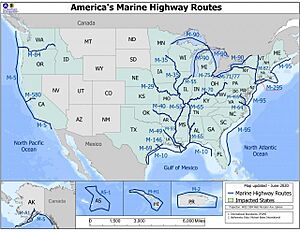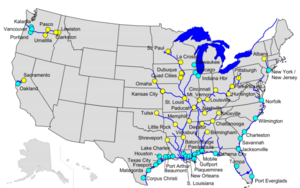America's Marine Highway facts for kids
The America's Marine Highway is a big plan from the United States Department of Transportation (DOT). It aims to use the country's huge network of waterways – that's about 29,000 miles (47,000 km) of rivers and coasts! The main goal is to reduce traffic jams and wear and tear on our roads caused by too many trucks.
In 2007, the government passed a law (Public Law 110-140) that said we should "Offer a waterborne alternative" to road transport. This means using ships and barges to move people or goods, which can help reduce traffic on land.
As more people live in the United States, we need to move more goods around. This means more trucks, more fuel used, and more damage to our highways. In 2008, Americans wasted about 3.7 billion hours stuck in traffic and used 2.3 billion gallons (8.7 billion liters) of fuel just sitting there! The government is looking at our waterways to help solve this problem, alongside other ideas like "buying local" to reduce how far things need to travel.
Studies show that moving goods by barge or ship is the most fuel-efficient way. It's like how much fuel it takes to move one ton of goods one mile (called a Ton-Mile). Shipping by water is over eight times more efficient than using big trucks and twice as efficient as trains! Also, ship captains don't have the same strict "hours driving" limits that truck drivers do. A truck driver can only drive 11 hours out of 21, which can cut their average speed in half on long trips. Traffic and stops like weigh stations can slow them down even more.
Contents
A Look Back: Water Travel's Past
Water travel has been super important in America since the first settlers arrived in Jamestown. For a long time, traveling by boat was just as common as using roads. Before World War II, oil from Texas was often shipped to the East Coast by tankers.
A big change happened in 1958 when the first containership, the SS Ideal X, sailed from New Jersey to Texas. This started a whole new way of shipping goods in large metal boxes (containers). The Marine Highway program is a modern effort to bring back more of this low-cost, environmentally friendly shipping using barges and ships where they haven't been used much recently.
How the Marine Highway Gets Funded
The United States looked at how Europe uses "Short Sea Shipping" (moving goods by sea over short distances). Our country decided on a different way to encourage businesses to use waterways again.
The United States Secretary of Transportation has pointed out several very busy highways in the U.S. that have good water routes as alternatives. These water routes are given an "M" name, like M-5, which is the water path along the coast that can be used instead of the I-5 highway between San Diego, California, and Seattle, Washington.
Once these "M" routes are identified, local and state governments can apply for special grants called "Transportation Investment Generating Economic Recovery" (TIGER) Grants. These grants help improve ports, making them bigger and more efficient. The idea isn't to pay shipping companies directly, but to make ports better so that shipping lines will want to use them. This way, the natural benefits of shipping by water (like being cheaper) will encourage local businesses to use these routes.
Today, moving goods between different types of transport (like from a truck to a ship) is very smooth. This is called intermodal freight transport. It means workers don't need to repack items, which lowers the chance of things getting lost or damaged. Many ports are really good at quickly moving a container from a truck onto a barge or ship, sometimes in less than a minute!
Things to Think About: Challenges
Protecting Our Environment
For many years, the U.S. has had rules about how ships handle their ballast water. Ballast water is water taken in by ships to help them stay stable. The rules are there to stop tiny plants and animals from one part of the world from being carried to new waters, where they could become invasive species.
Big shipping ports like the Port of Long Beach or the Port of New York and New Jersey have already seen some contamination over time. Short Sea Shipping will use these big ports as hubs to reach smaller, easier-to-access ports. Some people worry that this could lead to "secondary contamination" in these smaller water areas.
What About Trucking Companies?
The Teamsters Union, which represents many truck drivers, hasn't officially said what they think about the government supporting this new way of shipping. However, leaders in the Marine Highway program believe they are actually helping truckers. They think that by moving freight (goods) off busy roads where there aren't enough truckers for the amount of cargo, and onto ships, it will free up truckers for other routes.
They also believe the Marine Highway can handle a lot of the north-south shipping in the country. But it's important to remember that there are no east-west water routes, so those trips will always be done by land.
Truck drivers have rules about how many hours they can drive each day. These limits don't account for traffic, waiting to load or unload, or checkpoints. If a truck can drive onto a ferry or a special "Roll-on/Roll-off Vessel," the driver could keep their cargo moving towards its final destination while they take their required rest hours.
Concerns for Small Businesses
One good thing about shipping by truck is how convenient it is. The truck driver who picks up your goods is responsible for getting them to their final stop. But using Short Sea Shipping adds two more steps. First, a truck carries the goods from where they start to a port. Then, a barge or ship takes them to a second port. Finally, another truck picks up the cargo and delivers it to its final destination.
This means a business owner might have to work with one very large trucking company that operates in both ports. Or, they might have to arrange things with two different independent truck drivers. This could mean the cargo sits at the port for a while until the second truck is ready.
Rules About Foreign Ships
The Merchant Marine Act of 1920, also known as the Jones Act, is a law that stops foreign ships from carrying cargo or passengers between U.S. ports. This practice is called cabotage. Ships that want to move goods between U.S. ports must be built and registered in the U.S. Also, at least three-quarters of their crew members must be U.S. citizens or permanent residents. Large container ships that already stop at several U.S. ports could move containers between those ports cheaply, but these anti-cabotage laws prevent them from doing so.
Looking to the Future
The United States Navy is also looking at America's Marine Highway as a way to help their older Military Sealift Command (MSC) fleet. Right now, if there was a national emergency, the U.S. government would need a lot of help from foreign ships to transport its military forces, just like during past operations. The U.S. Navy and the Marine Highway program have agreed to work together. They want to create a special type of ship that is built and staffed by Americans. This ship could be used for regular trade during peacetime and also help move military supplies during emergencies.
Images for kids





